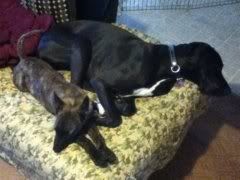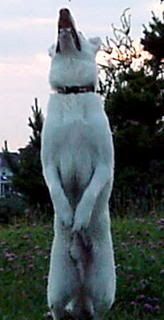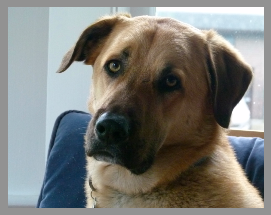 Corrections - the right way.
#354935 - 02/07/2012 03:43 AM Corrections - the right way.
#354935 - 02/07/2012 03:43 AM |
Webboard User

 
Reg: 05-25-2011
Posts: 439
Loc: Lawton, OK
 Offline Offline |
|
Ok, I'm going to broach the subject that seems to be off-limits, and quite honestly I never hear alot about. Even in training classes, training videos, or among dog owners the subject seems to be hush hush. Probably because people don't want to be criticized for using harsh methods, or what people perceive to be harsh. I know people that call giving a pop on a flat collar harsh, and I've heard of dogs being strung up in trees until they pass out (which I consider over the top).
There's alot of people on here that I respect their opinion, but I'd like to hear from as many people as possible about what (in their opinion) an appropriate correction would be for a certain behavior under certain circumstances, and what the correction was. Of course taking all things into consideration alot of things depend on the dog, but is there a baseline for appropriate correction that is across the board? And if there is, what is it?
For example, with my dane girl she gets head strong sometimes and doesn't like to listen to a simple command that I know 100% that she knows, yet she is choosing to ignore me. Such as when she is getting into the cupboards. I'll catch her looking at me out of the corner of her eye while she's doing what she's not supposed to, and even after I give her a command. I'll walk over and poke her in the ribs to get her attention, then tell her what I want her to do. If she listens, great, if not then I'll snap on her drag leash and she gets a flat collar correction if she does it again, which usually does the trick. If I have to give her any more of a correction over that, then she gets to wear her prong collar, and 99% of the time that solves the issue right there. I've used the three strikes and your out rule with her and it seems to work pretty well. She is a submissive female but will rebound from a correction fairly quickly (usually minutes). Once in a while I'll go from a verbal correction to her prong collar for the same infraction just so she doesn't learn that I only mean it when I tell her the third time.
I'm looking forward to reading the replies.
Cassy & Leo enjoying a nap.
 |
 Top Top
|
 Re: Corrections - the right way.
[Re: Ben McDonald ]
#354939 - 02/07/2012 08:41 AM Re: Corrections - the right way.
[Re: Ben McDonald ]
#354939 - 02/07/2012 08:41 AM |
Webboard User

  
Reg: 03-17-2006
Posts: 4203
Loc:
 Offline Offline |
|
I think if you need to stop something, corrections are always appropriate. My guess with the cupboard surfing, you didnt make the right association in her head because you havent been as consistant or timely as you needed.
She's had some success at getting in there and then way too late, you correct her. I think you'd do better with it by either setting her up with something in the cabinet so your correction can be timed right combined with teaching her some type of barrier or place command, or an ecollar with nothing verbal so she thinks her action caused the correction.
This is just my opinion Ben, but I think if she takes minutes to rebound from a correction, it wasnt real effective. Its more like she saw it as an unfair assault. Remember, its what her perception of it is, not what you actually did. The best corrections I've ever given have my dog immediately eager to do whatever correctly. And it doesnt always work out like that.
Corrections are difficult to talk about online Ben, its not as simple as rewarding or marking something when its correct. There's a ton of room for mistakes in the positive side of things with as many re-do's as you may need. With a few poor corrections you can mess things up pretty quickly with a lot of dogs.
|
 Top Top
|
 Re: Corrections - the right way.
[Re: Ben McDonald ]
#354952 - 02/07/2012 10:29 AM Re: Corrections - the right way.
[Re: Ben McDonald ]
#354952 - 02/07/2012 10:29 AM |
Webboard User

  
Reg: 10-09-2008
Posts: 1917
Loc: St. Louis, Missouri
 Offline Offline |
|
For me, it entirely depends on the temperament of the dog. The goal (IMO) is to give the least possible correction that gets the results you want. With a couple of baseline rules: Babies shouldn't be corrected, no dog should be corrected for something that they had no control over, you can't correct for something that happened while you weren't there, and no correction should ever cause harm (physical or emotional.)
Most of my "corrections" are verbal. A well-timed "uh-uh" is for small infractions (or a soft dog). I'm also pretty good at delivering a low, growly "Ahhhhh." That works too. "Hey!" shouted real loud means you better stop it right now.
But there are physical corrections in my arsenal too. Grabbing the scruff of the neck or a finger-poke to the rear are good for getting attention, or disrupting something in the act. I've also given wacks aross the nose for putting teeth on me, especially after a verbal correction has gone unheeded.
Physical blocking is pretty effective too. It doesn't require saying anything or touching the dog--you just step between them and the thing they want. You "take their space" and prevent them from getting at the desired thing. (That's one dogs seem to particularly "get")
Taking away a thing is also a correction. You took your sister's toy? Too bad, now it's mine.
Mine all wear prong collars when they are on leash. So I don't feel like I have to do much "correcting." That's the beauty of a prong collar. They dog is doing the correcting. I don't tug on the thing. If I feel pressure from any dog, I simply stop walking. I did nothing. You weren't paying attention.
In thinking about the ways I "control" my dogs--I think there's really more occurances of asking for behaviors that I do want than correcting for things I don't want. For example, I don't want dogs bolting out the door (or out of the car). I know that's what they would do, so I don't give them the opportunity to do it, and thereby have to "correct" them for it. Instead, everybody has to sit and wait at doors. If you make a move, I'm closing the door. You want to get out of the car at the park? Then sit down and wait for me to say okay. Or we will wait all day.
You want this bowl of raw meat? Then sit down, look me in the eyes and wait until I say you can have it.
When you figure out the things in life that are the strongest motivators for the dog (for most it's food, play, toys) and teach them that it is their OWN self-control that earns it...there's a lot less "correcting" that has to be done.
Either that, or I have gotten really lucky five times with these dogs. Cause it has worked with every one of them.
Cinco | Jack | Fanny | Ellie | Chip | Deacon |
 Top Top
|
 Re: Corrections - the right way.
[Re: Tracy Collins ]
#354954 - 02/07/2012 11:01 AM Re: Corrections - the right way.
[Re: Tracy Collins ]
#354954 - 02/07/2012 11:01 AM |
Moderator

   
Reg: 07-13-2005
Posts: 31580
Loc: North-Central coast of California
 Offline Offline |
|
In addition to the excellent points already made, I just want to say ditto to something crucial Steve said.
If the correction is not right that second, then I will probably pretend I didn't see it because of the complete ineffectiveness of a delayed correction. As mentioned, an attack out of nowhere is how a delayed correction will be perceived by the dog, IMO. The whole cupboard thing sounds confusing and dragged-out. I can't see the dog getting it the way she would if there was an INSTANT correction. If you have to set it up, then set it up, is my opinion.
I also agree 100% with this:
Most of my "corrections" are verbal. A well-timed "uh-uh" is for small infractions (or a soft dog). I'm also pretty good at delivering a low, growly "Ahhhhh." That works too. "Hey!" shouted real loud means you better stop it right now. .... In thinking about the ways I "control" my dogs--I think there's really more occurances of asking for behaviors that I do want than correcting for things I don't want. For example, I don't want dogs bolting out the door (or out of the car). I know that's what they would do, so I don't give them the opportunity to do it, and thereby have to "correct" them for it. Instead, everybody has to sit and wait at doors. If you make a move, I'm closing the door. You want to get out of the car at the park? Then sit down and wait for me to say okay. Or we will wait all day.
(from TRACY)
And all this is part of why:
Corrections are difficult to talk about online Ben, its not as simple as rewarding or marking something when its correct. There's a ton of room for mistakes in the positive side of things with as many re-do's as you may need. With a few poor corrections you can mess things up pretty quickly with a lot of dogs. (from STEVE)
Timing to me is probably THE most important aspect of corrections (after using the lowest level that still works). If it won't be perfectly timed , then I blew it and forget it this time. The dog does not get it if I "hold a grudge" or do angry on-and-on corrections until I'm over it. You'd be surprised at how many owners do just that, thinking that somehow a dog gets it when the owner keeps yelling about "you knew not to do that!"
|
 Top Top
|
 Re: Corrections - the right way.
[Re: Ben McDonald ]
#354956 - 02/07/2012 11:05 AM Re: Corrections - the right way.
[Re: Ben McDonald ]
#354956 - 02/07/2012 11:05 AM |
Webboard User


Reg: 03-24-2011
Posts: 779
Loc: Indianapolis
 Offline Offline |
|
I think correction should be based on the dog. I have a dog that cringes and hides when I deepen my voice regardless of what's going on or if she even did something bad, and I have a dog that I can beat with a stick and she still won't let go of the other dog she's decided to latch on to. I also have a dog that I can make a mistake with and he's perfectly happy to forget that it even happened mere seconds later.
ETA: My physical corrections are always because of drive. The dog is under-stimulated for whatever reason and suddenly flooded with something more interesting than me, and I'm unable to break them out of it without physically grabbing them and getting their attention. Mercy loves balls, food, me, being a good girl. If she sees a squirrel she gets tunnel vision and cannot snap out of it unless I grab her and physically remove her from it. It doesn't have to hurt to be a correction, but the act of physically stopping her, forcing her to look away, picking her up and bringing her somewhere else IS a correction itself.
I try to be fair to all of them. I mostly use verbal corrections. Yelling HEY! is usually when Radar is too busy bouncing up and down because he's so excited and he hurts me somehow. He quickly sits down and stays still after that. Ah! or AhAh! works for the girls. Shelby is a spoiled brat because my husband doesn't really work with her beyond play and walks, so she will stand there and stare at me, waiting for me to back up a command. She's such a chicken that all I have to do is point and glare and she slinks off to her pillow or follows the command.
|
 Top Top
|
 Re: Corrections - the right way.
[Re: Ben McDonald ]
#354984 - 02/07/2012 02:42 PM Re: Corrections - the right way.
[Re: Ben McDonald ]
#354984 - 02/07/2012 02:42 PM |
Webboard User

  
Reg: 07-09-2004
Posts: 1344
Loc: CNY
 Offline Offline |
|
Ben,
I agree with almost everything everyone has posted in response.
I might note that I read the last paragraph of your post with more attention. You offered as an example your dog getting into a cupboard and ignoring you... Um, I'm not sure I understand. The dog has done it more than once, even still, after your efforts - I realize it is an example, and as such I presume the dog responds to commands casually or intermittently - I may not have characterized your example correctly. If so, ignore the following.
In the first instance, the command "NO" is a very valuable command when it has been used to condition the dog to stop what it is doing. I can't imagine one of my dogs getting into the cupboards, garbage, whatever after two or three corrections - and the correction would be the command "NO!" No leash, no tethering, no collar... Just the prior conditioning of the command "NO."
I rely on a few basic commands to manage my mutts in the house - NO, ENOUGH, COME, SIT, DOWN, OUT, OFF, GET, LOOK, OK - accompanied by praise when warranted and stern looks also when warranted... If I touch the cupboards and say "NO" I expect the dog to avoid the cupboards. "NO" means "NO." My commands are not negotiable - after I've spent the time to make sure the dog(s) are conditioned to react to them.
Now, I know you know that a command is not a request but when I read your last paragraph I kinda thought I'd at least comment on the tone. I really enjoy my mutts but I enjoy them on my terms - makes for a more predictable atmosphere. And they are dogs, and occasionally we have to revisit the rules but not all that frequently.
As an aside, the foster dogs that visit before adoption seem to 'get' the rules quicker as a function of being part of the group, and mimicking the behavior of the dogs and their interaction with me. It is a good thing to have a dog that promptly reacts to the command "NO" - the first time.
And my idea of correction is to work with the dog confidently, so that - in my mind - the dog feels my confidence in myself and my pride in the dog. I use a good dog collar initially but mostly to get the dog to focus on me. Then it is play interspersed with training, if that makes any sense. I'm not into corporal punishment. And I use treats for reinforcement sparingly. Mostly it is consistency, no obvious dog favorites, patience... But in the first instance it has to do with a dog or dogs understanding who is the leader of the bunch. That would be me.
I probably was far from the mark. This is really a test to see if I mastered the posting protocols.
Mike A.
"I wouldn't touch that dog, son. He don't take to pettin." Hondo, played by John Wayne |
 Top Top
|
 Re: Corrections - the right way.
[Re: Ben McDonald ]
#354990 - 02/07/2012 05:42 PM Re: Corrections - the right way.
[Re: Ben McDonald ]
#354990 - 02/07/2012 05:42 PM |
Webboard User
  
Reg: 07-14-2007
Posts: 1243
Loc:
 Offline Offline |
|
Lots of great info for you Ben. The only thing I want to add in regards to corrections is the importance of the one doing the correcting.
The relationship is between you and your dog; so what feels right to you, improves the situation and has no negative effects on your relationship with the dog is probably the baseline to go for.
For instance; I probably wouldn't correct for getting into the cupboards to me its just not that big a deal. I'd leash her if necessary to remove her and then secure the cupboards to prevent her from getting into them but that is where the personality of the corrector is crucial; I am much better at managing the environment while I condition the "No" than timing an appropriate correction to stop the behavior. BTW I think Mike's points about "No" are wonderful. IMO it is one of the most underrated commands.
Just one other thing; the description of her looking at you from the corner of her eyes. It has nothing to do with knowing she is doing something wrong. Two things come to mind which would make me strongly suggest working on this situation from a different approach. One is that she is offering submission by not directly looking at you and averting her eyes or she is looking at you (showing a lot of white) as in guarding an object. In either case she does not understand she shouldn't be in the cupboard. Consider it a distraction and build her up to that level in her obedience.
|
 Top Top
|
 Re: Corrections - the right way.
[Re: Ben McDonald ]
#354992 - 02/07/2012 06:06 PM Re: Corrections - the right way.
[Re: Ben McDonald ]
#354992 - 02/07/2012 06:06 PM |
Webboard User

  
Reg: 04-29-2004
Posts: 3825
Loc: Northeast
 Offline Offline |
|
Yep, my top commands to teach are: No, Leave it ( to me 2 different commands for different pourposes) & recall.
MY DOGS...MY RULES
 |
 Top Top
|
 Re: Corrections - the right way.
[Re: Ben McDonald ]
#355013 - 02/07/2012 10:04 PM Re: Corrections - the right way.
[Re: Ben McDonald ]
#355013 - 02/07/2012 10:04 PM |
Webboard User
 
Reg: 12-06-2010
Posts: 721
Loc: British Columbia, Canada
 Offline Offline |
|
We are living in a renovation right now. That is, close quarters and very little heat. Skipper has been trying to be boss of the couch, but I do not agree with his posturing so when he growls as Jethro is getting up to get settled, I give him a quick indication that his input is not welcome. He settles down after that and everyone naps while I work. My indicator to Skipper is to put my hand between him and Jethro and give a light poke to Skipper's neck, like a nose bump. The best part is that they are starting to sleep like a pack, that is, cuddling up with each other.
To communicate with my dogs, I try to use calming signals, verbal commands, and body language for corrections.
I learned the hard way that inflicting pain had the opposite effect on Jethro. It never calmed him down or alleviated his arousal over a distraction. What has been working the best is continuing to build his attention on me through recall games and a broad number of sounds and actions that all pretty much mean, "Leave that alone and come back over here by me, or follow me away from that thing." I like using a variety of sounds and actions because I find saying Leave It, No, and Uh Uh over and over again boring. Jethro seems to enjoy the different sounds and actions, too. If I can't get his attention one way, I try another, which utilizes a different cognitive/sensory input. It makes it fun for both of us and he is getting ever so much better at breaking off his gaze to turn his attention back to me.
That said, I really, really, really like a solid Sit. We work on that every day many times a day in many different situations. And when all else fails (Skunk!), I pull them in nice and close and make a speedy exit, hopefully not tripping over the little dog or getting knocked over by the big dog.
|
 Top Top
|
 Re: Corrections - the right way.
[Re: Ben McDonald ]
#355050 - 02/08/2012 02:25 PM Re: Corrections - the right way.
[Re: Ben McDonald ]
#355050 - 02/08/2012 02:25 PM |
Webboard User

  
Reg: 09-23-2011
Posts: 2692
Loc: Marrero, LA
 Offline Offline |
|
As you can gather from the previous posts, corrections aren't freely discussed because every dog and every situation are different.
I have a VERY stubborn, hard GSD female (hence the nickname "Crazy bitch"). She is mostly obedient, especially to her working and training commands; "Uh-uh" is "that's not what I told you to do, try again; "No" is a strict verbal correction; "Move", "Wait", and "Go lay down!" are self-explanatory. She understands these. Her problem is she resists the first (and sometimes second) recall, and tends to ignore commands in a social environment.
My dog recovers from even the harshest prong corrections instantaneously and is eager to go back to work. Even if she yelps because it hurts, she knows what the correction is for and how to correct it. HOWEVER, maybe due to something in her previous home, she cowers from hand corrections and, even though I don't give her hand corrections, she avoids my hands when she returns after a failure to recall.
In summary, all dogs react differently to corrections and some have different responses to different corrections.

Sadie |
 Top Top
|
When purchasing any product from Leerburg Enterprises, Inc. it is understood
that any and all products sold by Leerburg Enterprises, Inc. are sold in Dunn
County Wisconsin, USA. Any and all legal action taken against Leerburg Enterprises,
Inc. concerning the purchase or use of these products must take place in Dunn
County, Wisconsin. If customers do not agree with this policy they should not
purchase Leerburg Ent. Inc. products.
Dog Training is never without risk of injury. Do not use any of the products
sold by Leerburg Enterprises, Inc. without consulting a local professional.
The training methods shown in the Leerburg Ent. Inc. DVD’s are meant
to be used with a local instructor or trainer. Leerburg Enterprises, Inc. cannot
be held responsible for accidents or injuries to humans and/or animals.
Copyright 2010 Leerburg® Enterprises, Inc. All rights reserved. All photos and content on leerburg.com are part of a registered copyright owned by Leerburg Enterprise, Inc.
By accessing any information within Leerburg.com, you agree to abide by the
Leerburg.com Privacy Policy and Terms of Use.
 Previous Topic
Previous Topic Index
Index Next Topic
Next Topic













 Top
Top







.jpg)